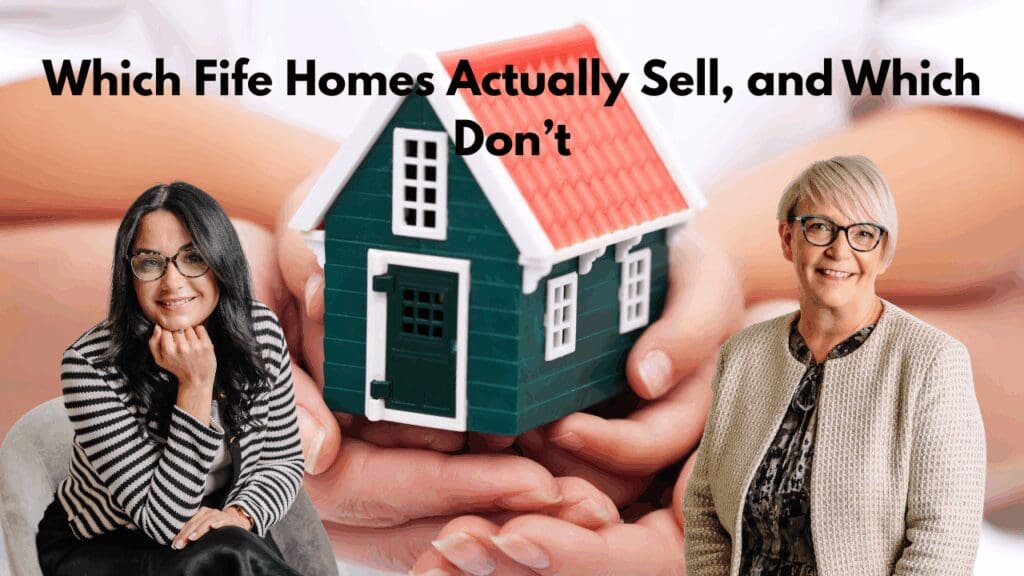
Some homes in Fife fly off the market within weeks. Others sit for months, attract only a handful of viewings, then quietly disappear from the portals, unsold.
The difference isn’t luck, it’s sellability.
Would it surprise you that of the 10.94 million homes that have left UK estate agents books since January 2019, only 6.33 million sold and moved (or 57.86% of them). The other 4.61 million came off the market unsold. This is the extent of the sellability issue.
Looking more locally, the past two years of data reveal a clear pattern in Fife’s market. Some types of homes are far more likely to sell than others. Let’s look at what the numbers show and what that means for homeowners and landlords across the area.
Sellability by Fife Property Type
Let’s start with property type (comparing it to the national figures):
In the past two years, 80.94% of houses in Fife that left all estate agents books in the area sold and completed (i.e. the home owner moved), compared with 61.04% nationally.
85.71% of Fife flats and apartments sold, while nationally it was 45.98%.
Whilst 89.10% of bungalows sold in Fife, compared with 57.35% nationally.
Sellability by Fife House Price Range
Price, of course, changes everything. So, looking at the last two years:
At the lower end, Fife homes priced up to £250,000 sold 87.03% of the time, compared to the 63.16% national figure.
Between £250,000 and £500,000, 73.91% of Fife homes sold (and completed) versus 54.25% nationally.
68.37% of £500,000 to £750,000 priced Fife homes found buyers and sold, compared with 45.77% nationally.
Above £750,000 to £1 million, the sellability of Fife homes rises slightly to 69.31%, while nationally it’s 42.47%.
And finally, in the £1 million-plus bracket, 59.38% of listings in Fife resulted in a completed sale, compared with 34.78% across the UK.
It shows that generally, the higher the price, the lower the sellability rate, maybe because the number of buyers able or willing to pay top end prices in Fife is limited.
Why Some Fife Homes Sell and Others Don’t
The numbers tell us what happened, but not why. The reasons usually fall into three camps.
1. Price positioning.
Every home has a price window where it attracts maximum interest. Start too high and you miss the crucial first few weeks when buyers are most active.
Denton House Research found after analysing over 2 million house sales, that properties finding a buyer within 25 days have a 94% chance of the sale completing (i.e. you moving). After 100 days, even if the home does sell (which is slim), the chance of your sale getting to completion (and you moving home) drops to 56%.
Roughly half of all homes that come to market ever find a buyer. But for the ones that do, speed matters. 41.8% sell within the first 28 days, 70.9% within 63 days, and by 100 days, 77.7% have agreed a sale.
Starting with a realistic price is further backed up with data from Hamptons that shows of the millions of homes that have sold since 2001, aside from the Covid year, British homes have typically sold within about 0.9% to 1.3% of their ‘final’ asking price (final as in the headline asking price before it went sale agreed – not the original asking price if it was reduced in price after it came on the market). This again shows how vital it is to price realistically from the start.
2. Marketing quality.
Buyers buy with their eyes. Listings with poor photography and weak descriptions get scrolled past. Presentation can be the difference between a viewing and a swipe.
3. Agent skill and communication.
The best Fife estate agents keep momentum. They update, negotiate, and manage buyers and solicitors through the sticky middle of a transaction. Others simply upload to portals and wait. The difference shows up in these sellability figures.
What It Means for Fife Homeowners Planning 2026 Moves
The Fife market is not broken, but it is selective. The data shows that most homes priced sensibly will sell. It’s the ones that start too high or stand still that struggle.
In estate agency, sellability isn’t luck. It’s about strategy, the right price, the right preparation, and the right partner guiding the process.
If you’re thinking of moving in 2026 and want an evidence-based view of how sellable your Fife home really is, ask for the facts before you list. The numbers rarely lie and knowing them could be the difference between a For Sale board and a Sold sign.
